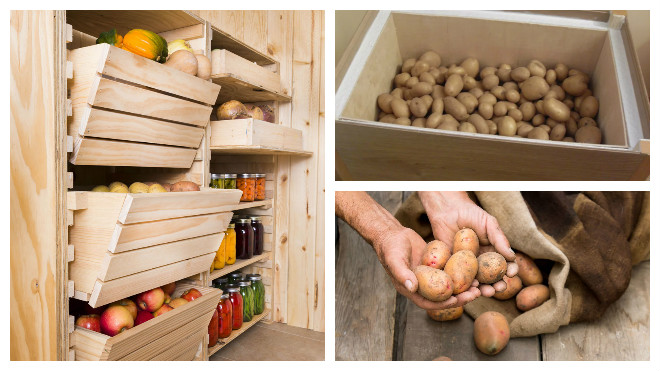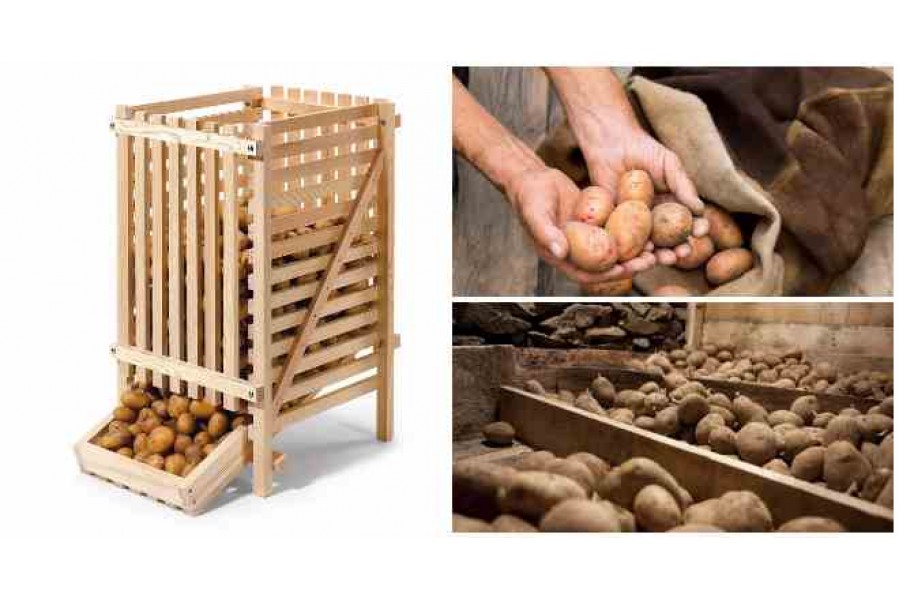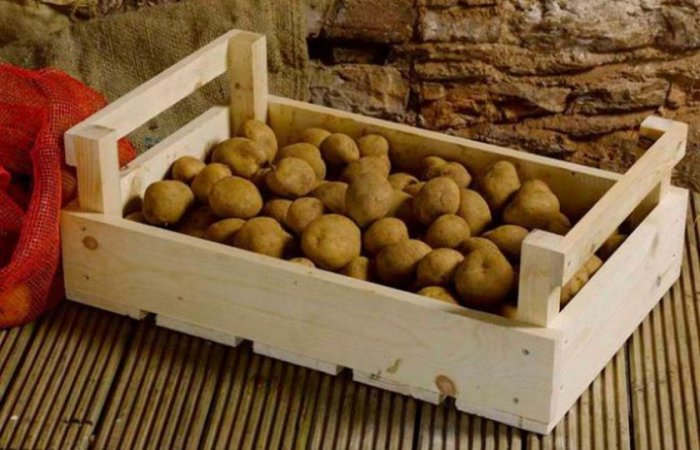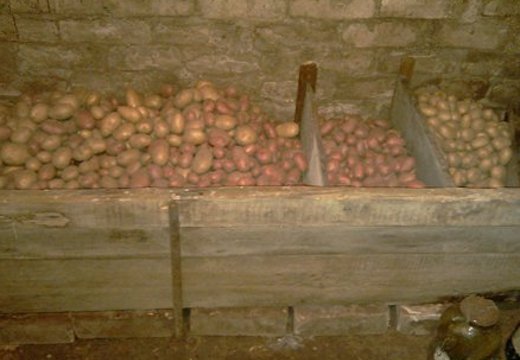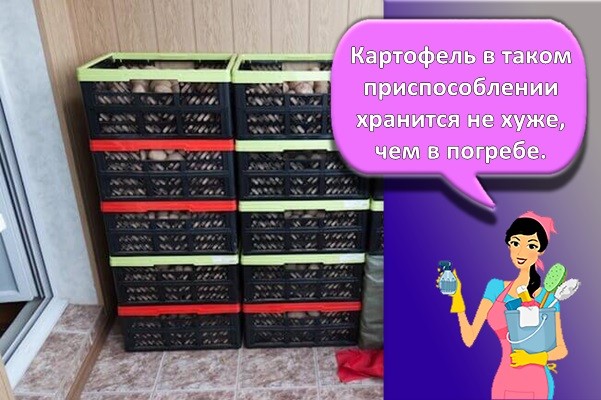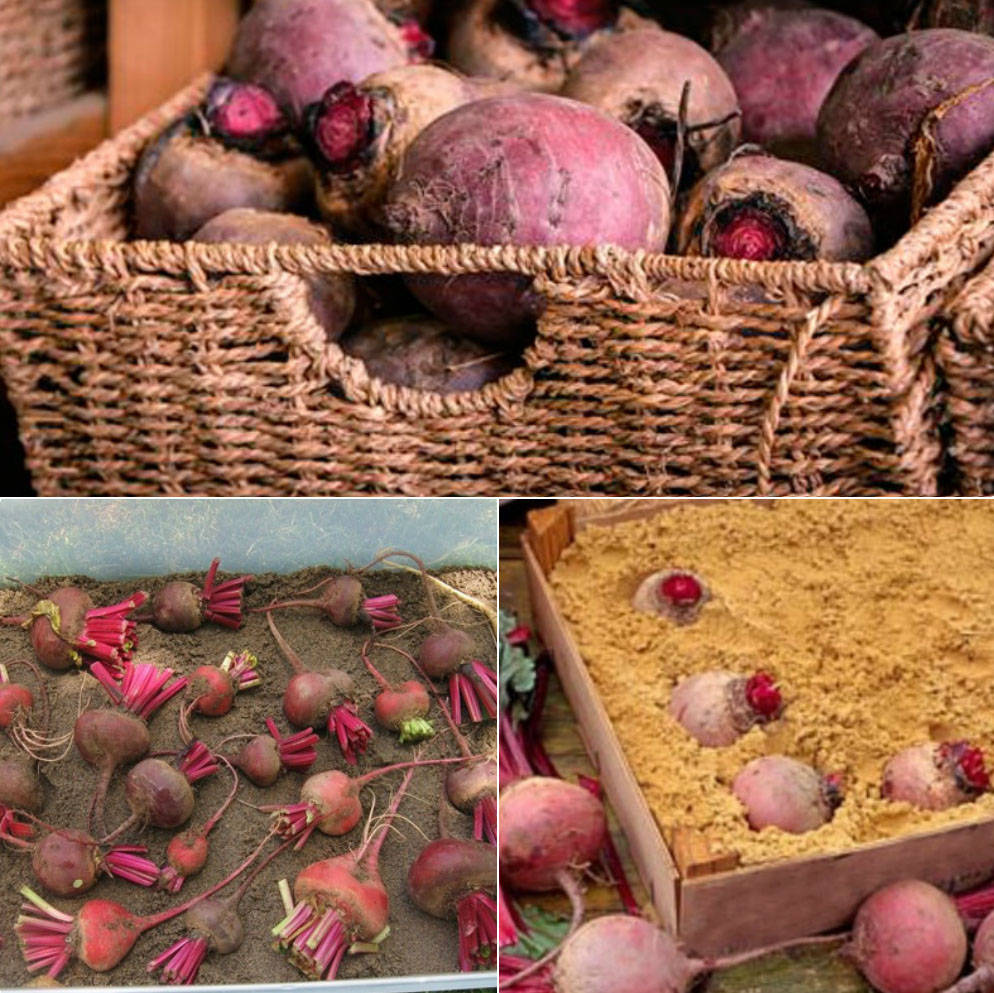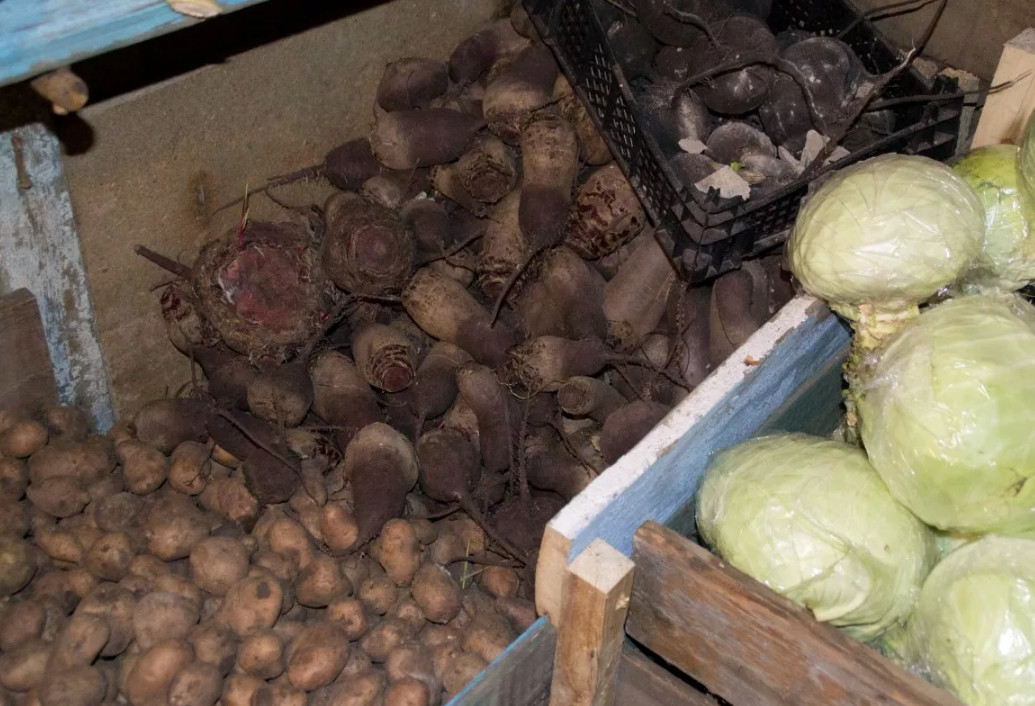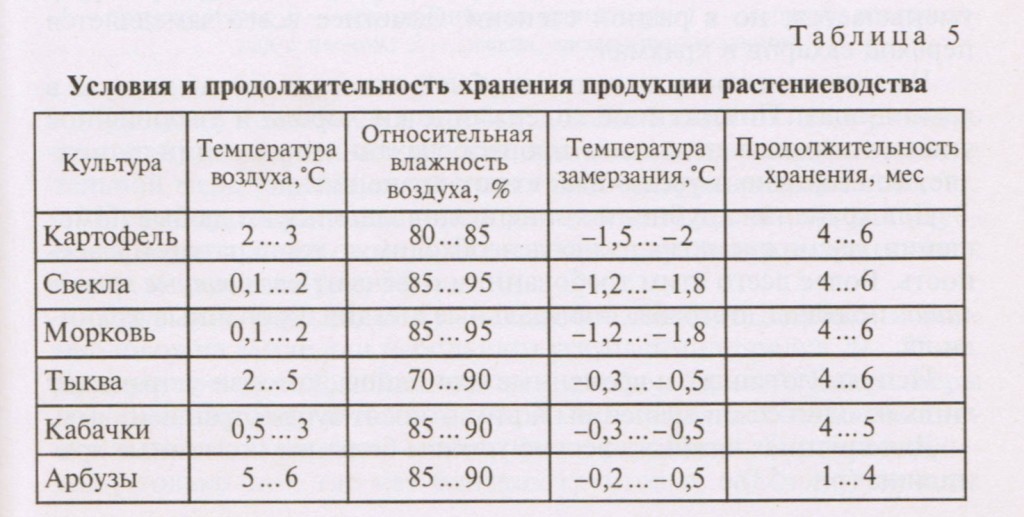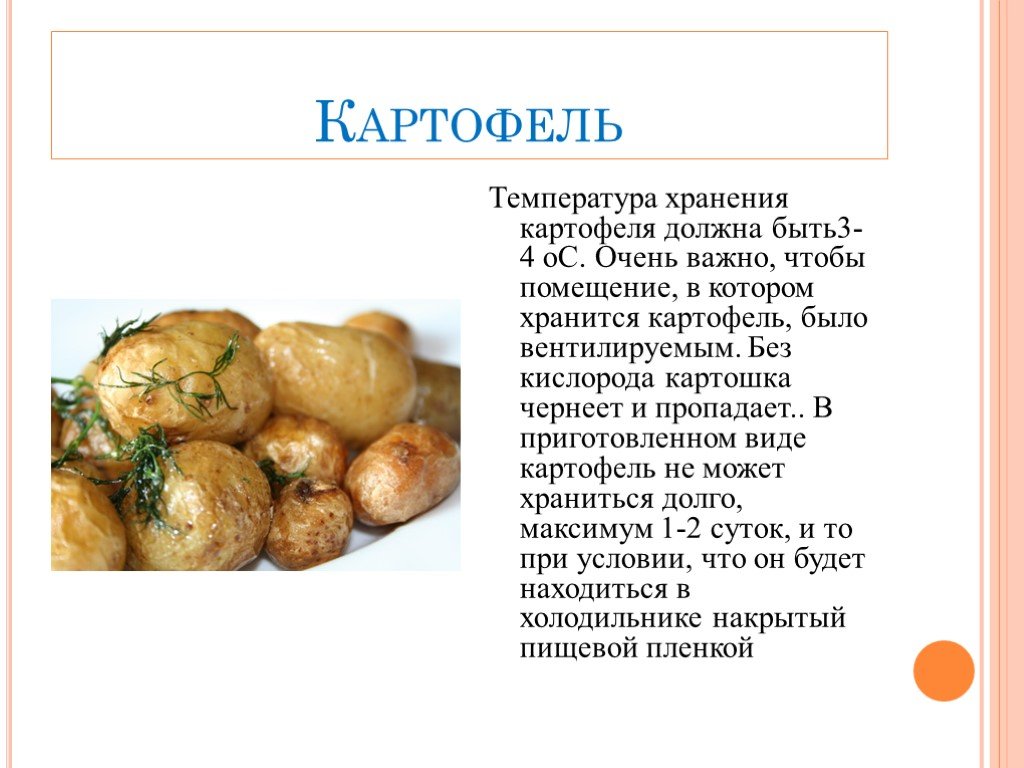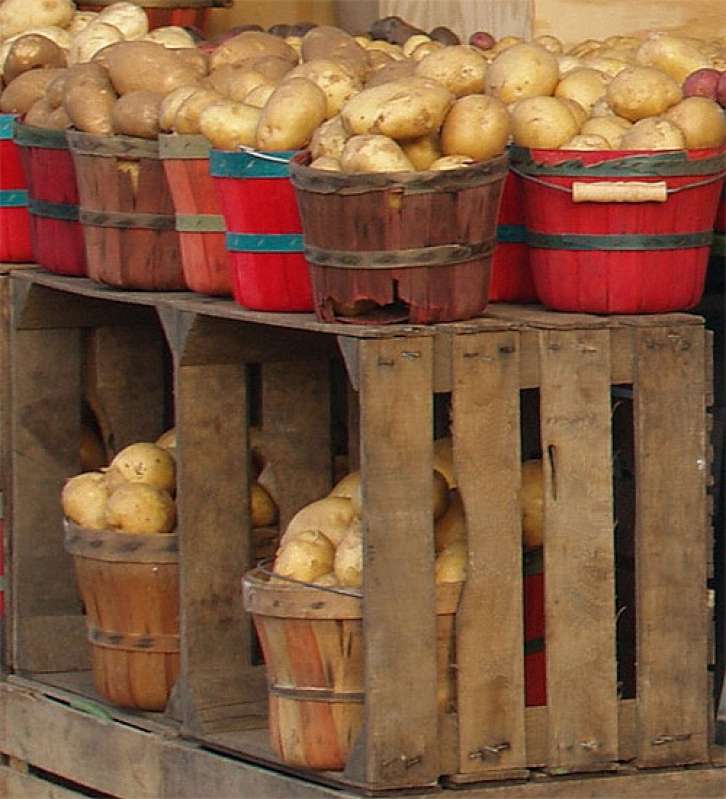How to properly prepare potatoes
After digging, the potatoes are not immediately sent for storage. The tubers are dried, ripened, and mechanical damage is healed.
Air-sun bath
If the weather is good, the tubers are scattered to dry on the arable land, and in the rainy season they are carried away under a canopy. Potatoes are kept in the sun for no more than 2 hours, then they are dried for 2 weeks in a barn or under a canopy. Ultraviolet rays, they make up 10% of the spectrum of sunlight, have a bactericidal effect, kill fungi and bacteria, and increase the keeping quality of potatoes.

Healing
Mechanical damage during digging cannot be avoided. Skin wounds can get infected. They dry quickly and become covered with dry skin at a temperature of 13-18 ° C. It takes no more than 2 weeks to heal. If the temperature is lower, the process is delayed up to 3-4 weeks.
Falling asleep
The tubers must undergo a gradual cooling period before being stored. In industrial potato storage facilities, the temperature is reduced daily by 0.5 ° C. The process lasts 10-15 days. Summer residents are helped by the weather. When the air temperature drops to 2-4 ° C, the potatoes are sent for storage. Due to a gradual decrease in temperature in tubers, all processes (physiological, biochemical) are stopped.
In what conditions to store potatoes
You need to store potatoes at home, observing certain rules.
Before laying the tubers for storage, the room should be prepared. It must be cleaned, all sources of decay must be removed, and the walls must be treated with hydrated (5%) lime. This will help prevent mold growth in the areas where vegetables will be. It is imperative to equip the cellar (basement) with ventilation: this will help increase the shelf life of potatoes. It is advisable to place the crop in boxes with a volume of 15 - 20 kg, the bottom of which must first be lined with straw, sand or sawdust in order to absorb excess moisture. Cover the potatoes with a thick cloth or a layer of hay to protect them from freezing. Several fresh apples are placed among the potatoes. They will slow down the germination process of tubers.
It is important that the fruits do not rot (they are stored less than potatoes). In this case, they are replaced with fresh
Planting potatoes must be stored separately. If tubers are stored in the form of a mound, it should not be more than 1 meter high.

First, the earliest varieties of vegetables are used: such root crops will not be stored for a long time. And if such a potato remains until December, it must be stored as a planting potato. Tubers no longer represent nutritional value: they become shriveled, dry, tasteless.
- The storage temperature for potatoes should be between + 2 ° C and + 4 ° C. Therefore, if the vegetable is stored on the balcony in frosty winter, the tubers are insulated with old blankets or outerwear.
- The humidity level in the storage areas of root crops should not exceed 85%. But also the air should not be allowed to be too dry.
- It is necessary to illuminate the cellar (basement) exclusively with electric light of minimum brightness, so as not to contribute to the greening of potatoes and the production of solanine. If this happens, it will no longer be possible to eat such a fruit.
- You can store the crop of potatoes in boxes, boxes, bags or just in bulk until May.
Where is the best place to store potatoes?
Those who want to know how to properly store potatoes in winter in a city apartment should adopt the following options:
- Place under the sink. A dark and enclosed space with high humidity keeps the components in shape. The main thing is that all the above requirements are met.You should not put plastic bags on storage of potatoes; it is better to adapt a box or wicker basket for this.
- Balcony, loggia. In this case, you need to either bring the environmental conditions to optimal, or pack the potatoes according to all the rules. Inventory should be checked from time to time to make sure everything is in order with the bookmark.
- In fridge. This option is applicable for storing vegetables in small volumes. But the temperature and humidity indicators required for root crops are always within the required limits. In the refrigerator, unlike other places, potatoes should be kept in plastic. Thanks to this, it will be possible not to worry about the fact that the flesh of the vegetable will begin to exude extraneous odors.
- Corridor at the entrance. Another place suitable for temperature indicators. In order not to worry about the safety of the product, a large box with a lock should be placed in the room, which is screwed to the floor or walls with screws.

Remember that potatoes can go bad even if they are in the refrigerator. Most often this happens not because of violations of the rules for its storage, but because of the initial purchase of not the highest quality product. There is nothing to be done here. If characteristic dark spots appear on the surface of tubers or their pulp, it is better not to use such a product for food. In any case, it is practically devoid of nutritional value and taste.
Storage conditions for potatoes
To keep more potatoes healthy, the following requirements must be met.
In any type of storage, maintain the air temperature within +2 .. + 4 ° С. At this temperature, the potatoes are dormant - they do not form roots and do not freeze. Lower temperatures promote the conversion of starch into sugars, while higher temperatures trigger the process of root formation.
The store must have thermometers to measure the temperature, as well as the ability to take action when it changes. If the temperature rises quickly, open air vents, arrange ventilation.
The air humidity in the room where potatoes are stored should not exceed 70-85%. To determine, install a hygrometer in the room. An increase in humidity contributes to the appearance of mold fungi. The air in the room is dried or ventilation is used.
The bottom of the potato storage should be covered with sand, preferably quartz, pebbles, gravel, and other material that absorbs moisture. The bottom of the cellar and other types of storage facilities cannot be cemented, covered with linoleum, smooth slate, floorboards and other similar materials, as this accumulates moisture, which contributes to the appearance of mold, and other negative processes.
Daytime and long-term artificial lighting is unacceptable in the store. Light promotes the production of poisonous solanine in potato tubers. The external manifestation of the production of solanine is the greening or dark green color of the tuber. These potatoes are not edible.
To save potatoes from winter pests and diseases, you need to carefully prepare the room and, accordingly, arrange the tubers in a convenient container.
- Isolate the storage from outside pests: mice, rats, slugs.
- Disinfect the premises from fungal and bacterial infection (burning a sulfur checker or just lumps of sulfur on a metal pallet or use other methods of disinfecting the premises).
How to store potatoes if there is no cellar
So, we are talking about possible storage options for potato tubers, if there is no basement, and you choose which one suits you best.
In an apartment (private house)
If it is decided to determine the potatoes for the winter in a residential building, then it should be placed in the coldest places - near the balcony or near the windows. In a private house - at the front door or in the hallway (at freezing temperatures).In this case, it is advisable to keep the tubers in cloth bags, since they do not interfere with the necessary ventilation.
Tip To avoid dampness and crop rot, you can put beets or dry straw on top of the bags.

If there are no cool places in the apartment, then it is permissible to place potatoes in a driveway pocket or closet. In this case, wooden boxes can be used. But it should be borne in mind that in the warmth the shelf life of the crop will be significantly reduced. To extend it a little, you can do the following - take a small plastic container, make 30-40 small holes in it, put a damp cloth and place it inside a box with potatoes.
Another option for wintering potatoes in an apartment is a thermostat. It is a mini-refrigerator with adjustable temperature and humidity. The disadvantage of this device is its small useful volume - only a few tens of liters.
On the loggia
The loggia gives a wider choice of storage options. But a prerequisite for the winter placement of vegetables should be its glazing.
With a plus mark on the thermometer, storage is not particularly difficult. The optimum temperature on the loggia is maintained even in case of slight frosts outside the window. The main thing is to exclude light from entering the product, as well as a strong increase in temperature and its sudden changes (for this, the crop is covered with warm clothes or old wadded blankets).
In the event of frost, take care of the thermal insulation of the crop, as well as maintaining proper conditions inside the storage. There are several ways to do this.
The easiest one is to buy an oven. It independently maintains the required storage temperature and ventilates the potatoes. If this is not possible, then you can make a similar device yourself:
- Build a double-walled drawer;
- Place insulation (polystyrene, sawdust, etc.) between the walls;
- At the bottom of the box, place incandescent bulbs placed in protective light-insulating metal housings (a thermal relay is also built into the system).
Help Instead of lamps, it is possible to install a plastic pipe through a hole in the wall. An electric hair dryer is placed in it, which supplies heated air to the tubers. As a result, the process of heating and ventilation of the storage takes place.

In regions with not very cold winters, an option with heating the loggia is possible. In this case, light-tight wooden boxes larger in volume than an oven are sufficient for storing.
Is it possible to save a vegetable until spring without a cellar in the ground
Storage in a pit is a non-standard method:
- Choose a place on your personal plot that is not flooded with water;
- Dig a hole about one and a half meters deep, its area depends on the volume of the laid crop;
- Arrange a drainage at the bottom, for this, make several grooves 10 cm deep at the edges;
- Cover the bottom and sides with straw;
- With the first frosts, place the tubers in the pit - the storage is filled so that about 30-40 cm remains to the top edge;
- Cover the supplies with a layer of straw;
- Create a hill 50-80 cm high above the storage (it should overlap the walls by more than 1 meter);
- In case of severe frosts, additionally cover the hill with a layer of snow, straw or other insulating material.
This method is very inconvenient, since it is rather problematic to extract the crop from such storage in winter. It can be recommended for storing seed.
Conditions
Potatoes are an unpretentious crop, so there are no problems with their preservation. The greatest role for the shelf life is played by:
- a place;
- container;
- temperature;
- humidity;
- lighting.
A place
When the vegetables are sorted and selected, they choose a place in the apartment where the tubers will be located. It should be away from heating appliances and other perishable crops.The most common places where potatoes are harvested in an apartment are:
- pantries;
- glazed balconies;
- dark cabinets with closing doors.
The place must be chosen based on the amount of potatoes. If a lot of it is consumed, then only a large pantry or balcony will do, if there is a cellar. It is convenient to keep in the closet no more than a couple of buckets of tubers.
Container

The main point in the selection of containers is its ventilation. It is imperative that air flows to the potatoes, otherwise it shrinks or rots. Most often it is stored in slotted wooden boxes. The top of the drawer can be covered with a loose lid.
If the number of tubers is small, then you can pour them into a plastic bucket, the bottom of which is lined with paper to protect it from moisture. It is allowed to store potatoes at home in plastic bags or kuli, only they are not tied on top.
Temperature
The lower the temperature, the longer the potatoes will be stored. The best option is to maintain the temperature at a level from plus 10 to 16 degrees. At a higher temperature, potatoes begin to soften, lose their taste and germinate. The germination process is especially active towards the end of spring.
Too low temperature is also harmful for tubers: they freeze and become tasteless. In addition, potatoes deteriorate quickly in the cold and are not suitable for food.
Lighting
A prerequisite for proper storage is the absence of daylight. You can store tubers in a dark place for a long time, but if you put them on the sun's rays, the skin wrinkles, and the fruits themselves lose some of the juice and become dry. The sun stimulates the awakening of the eyes, so shoots will soon appear on the tubers.
In the dark, the eyes "sleep" until mid-spring and only with warming do they wake up and grow on the surface of the vegetable.
Humidity
A place in the house is selected for the culture so that the humidity is at a minimum level. 15-50% is enough for the potatoes to lay well. With increasing humidity, rot is observed, which spreads very quickly. Humid air also promotes the germination of eyes, which are not needed at all for storage and will only reduce its life.
Preparing seed potatoes for storage
Harvested potatoes must not be stored immediately. The peel of such a vegetable is still thin and not ripe enough. To make it denser and small lesions heal, hold the seed in a well-ventilated place for two weeks.
It is also useful to green the seeds in the light. For this, the tubers are laid out in one layer and periodically turned over. Daylight contributes to the accumulation of corned beef in them. This is a poison, so the potato becomes inedible for rodents, and its resistance to diseases increases.
After drying and ripening, the seed is carefully examined again, rejecting spoiled specimens. To enhance immunity, the seeds are treated with one of the fungicidal preparations. For this purpose, "Maxim" or a weak solution of copper sulfate is often used.
When preparing the composition, 2 g of the substance is diluted in one bucket of water. After processing, the potatoes are well dried.

How to prepare a cellar for storing potatoes
Potatoes are quite picky about storage conditions, as they contain a lot of starch and water
Accordingly, before laying the crop for storage, you need to pay special attention to the preparation of the cellar. It is best done 1-1.5 months before harvest.
Preparatory work in the cellar includes the following actions:
- Check and clean all vents to ensure good air circulation in the room.
- Waterproofing the floor if it is too wet or there is groundwater near the soil surface.
- External thermal insulation of the cellar to protect against severe frost and overheating.The ideal option is to build a small cellar above it, which will protect the storage ceiling from high and low air temperatures.
- Sealing the door covering the vault so that it does not allow drafts to pass through. Outside, it is recommended to sheathe it with foam for better thermal insulation.
- Additional heating in the cellar with dark-painted lamps hanging in the corners of the store. When turned on, they will emit heat, which will help protect the cellar from freezing during extreme cold weather.
- Removing debris and excess junk that takes up a lot of space and can attract rodents.
- Eliminate holes in walls or floors with cement mortar or sturdy metal sheet to prevent rodent hazards.
Did you know? The homeland of the potato is South America: it still grows there in the wild.
Room processing
In order for the potatoes in storage to retain their good appearance and taste until spring, it is necessary to carry out the correct processing of the room. This procedure gets rid of microscopic harmful bacteria and prolongs the shelf life of potatoes.
Video: Processing the cellar before laying vegetables
The main recommendations for processing storage are presented below:
- the walls must be well disinfected with a solution of 10 liters of water, 2 kg of lime, 150 g of salt and 1 kg of vitriol. Bulk ingredients are dissolved in water and the resulting mixture is treated with the ceiling, floor and all walls of the room;
- processing the cellar with a sulfur checker. It must be brought into the room and set on fire so that the smoke permeates all the walls, ceiling and floor of the storage;
- if the previous crop of potatoes during storage in this cellar was covered with mold, then disinfection should be carried out twice with an interval of 7–8 days.
Important! It is better to handle the storage in warm and sunny weather, so that the room is well ventilated, and wet walls dry out faster.
Preparing the storage container
The easiest way to store vegetables is to place them on the floor of the cellar in the form of one large pile. But if among the tubers there are at least a few damaged or rotten fruits, then they will cause the appearance of rot on most of the rest of the potatoes, therefore, it is better to store the crop in specially prepared capacious containers.
They must meet the following requirements:
- the best material for making containers for potatoes is wood;
- the box and container for vegetables must have openings through which ventilation will take place. You can place boxes in horizontal rows on wooden supports, or stack them on top of each other;
- separate fabric bags are also suitable for storing tubers, which allow air to pass through well and protect the fruits from rotting. The bags should also be placed on wooden pallets 10–15 cm high from the floor;
-
potatoes in the cellar can be stored in nets, but tubers can freeze in them. To prevent this from happening, the nets with vegetables are covered on top with a layer of straw or a warm blanket.
Pretreatment of containers for storing potatoes also contributes to the good preservation of the crop. It is best to carry out this procedure in warm and sunny weather.
Processing is carried out in this way:
- All containers for potatoes are taken out into the street, cleaned of soil and the remnants of last year's vegetables.
- For disinfection, the container is treated with a hot concentrated aqueous solution of potassium permanganate.
- Leave the containers in the sun until they dry completely, and then bring them back into the cellar.
Important! The small size of these containers helps to divide the potatoes into small portions and reduce the risk of losing the entire crop due to rotting of several tubers.
Preparing for long-term storage of potatoes
- First, the tubers are carefully examined for damage and signs of disease.If any are found, they are also sorted by conditional groups.
- Broken, scratched or otherwise damaged root crops are selected for priority use, or given to livestock for feed.
- If signs of any infections are found, they are disposed of.
- Further, the fruits are cleaned of dirt, but not washed, but simply wiped off, since moisture can provoke rotting.
- It is advisable to let the harvested crop dry a little, but not overdry.
- After that, the potatoes are laid out inside the prepared container.
- If necessary, carry out antimicrobial treatment. To do this, you can grate the garlic and put it in compartments or nets at the rate of one hundred grams of garlic per one hundred kilograms of harvest.
- But it is also permissible to sprinkle the deposits with dry mountain ash leaves, spray with onion or mountain ash tincture.
Cellar storage

Lime is a cheap and effective remedy for cellar disinfection.
For this purpose, a number of preparatory activities are carried out:
- preparation of lime mortar;
- disinfection of metal objects;
- fumigation;
- airing;
- liming the walls.
The preparation of a lime mortar consists of dissolving two kilograms of lime, one hundred and fifty grams of copper sulfate, and a bucket of water. Disinfection of metal objects is carried out by treating racks, handrails, shelves, and other components with copper sulfate.
Next, the walls should be whitewashed, after which the room is fumigated with tansy or wormwood, after which it is well ventilated.
It should be noted that the cellar or basement must be well ventilated - the greenhouse effect cannot be provoked. The crop is placed directly in compartments or special nets, boxes.
The temperature regime is provided - from eighteen degrees below zero to one degree with a plus sign. This interval is explained by the fact that at first the temperature should be higher - about 18 degrees, then it gradually decreases to five, and then at least two degrees of heat are left for the winter.
No lighting required.
Balcony storage
- A special container box is knocked together, into which the roots are placed in bags or in nets, and closed.
- It is advisable to cover the top with old blankets, felt, and other warming material.
Oven
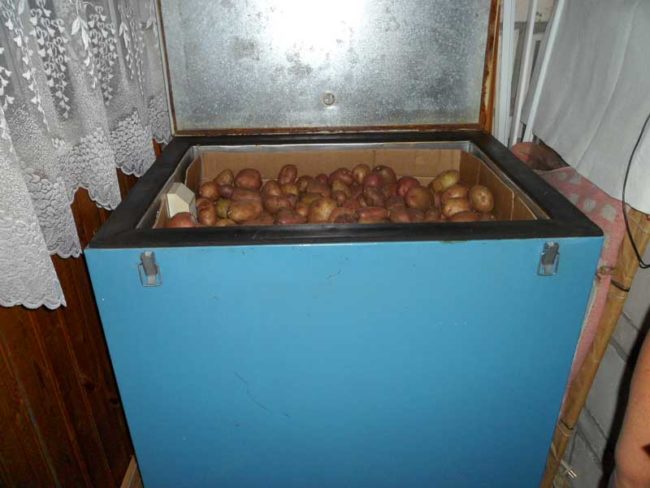
The finished oven is equipped with electric heating and a temperature controller.
And you can also equip a heating cabinet. Such constructions are purchased off-the-shelf. Using them to store potatoes, it is not necessary to pre-place the crop in bags - they are poured directly into the cabinet.
In a similar oven, the manufacturer has installed a special thermal mode, that is, the optimum temperature is constantly maintained. It is allowed to install such cabinets on the balcony, in the apartment. The main advantage of the equipment is the fact that a forced ventilation system is initially built into it - the owner does not have to worry about airing the crop. However, this type of storage is powered by electricity, so it may not be a very economical method.
Storage in the apartment

You can store small amounts of potatoes in your living area for daily cooking.
The most suitable varieties are Bronnitsky, Lasunak. It is worth noting that lying in an apartment for more than four months contributes to the deterioration of tubers - wrinkling, sprouting of eyes, the occurrence of dry or wet rot.
Another possible disadvantage of apartment storage is the fact that the temperature in the room should be lower than what is usually maintained for human living. In addition, it is advisable to keep the window open at all times.
Conditions

A cabinet under the kitchen window for storing potatoes and other vegetables.
In order to ensure optimal conditions, it is recommended to observe certain measures. Primary requirements:
- use of containers only from natural materials;
- the location is at the window;
- constantly open window;
- provision of ventilation;
- compliance with the temperature regime - 15 degrees.

Potatoes spoil quickly in the refrigerator.
However, you can restore the taste by placing the potatoes on the balcony or in the cellar. After about three days, the taste will be restored. You can only use an old refrigerator for storing potatoes, which no longer works. It is installed like an ordinary box on the balcony. Conditions are created that are standard for an ordinary box with one difference. Due to the fact that the refrigerator has thick thermo walls, it is not necessary to use a warm covering material.
Storing potatoes in an apartment, at home
Storing potatoes in the refrigerator is a bad way out: in closed bags, they will quickly deteriorate, and in open ones, they will poison the atmosphere and spoil other products. And the volume of the refrigerator is small. Therefore, it is necessary to find a suitable place in the apartment.
How to choose a seat
Usually they try to place potatoes right in the kitchen, although this is not ideal. The coldest place is usually near the doors (including the balcony), but even there the temperature is rarely below 15-16 ° C, so we will focus on a maximum of a month. Sometimes cool pantries are used, if available. In the kitchen, potatoes are usually placed under the sink in a wooden box or basket. As a rule, this place is closed from light and ventilated normally. Since it is difficult to store potatoes in an apartment, some methods often come to the rescue, the simplest of which is laying it with mint or wormwood leaves. It's good if there are beets nearby (in fact, the same techniques are used outside the apartment).

Small quantities of potatoes are stored under the sink
Types of storage containers
You can store potatoes in any "breathing" container:
- linen bags;
- nylon nets;
- wooden boxes;
- wicker baskets.
The volume may vary, but it rarely makes sense to keep more than a sack of potatoes in an apartment (that is, 4–5 buckets). It is bad to keep potatoes in plastic bags without holes or in any metal container.
How to make a box
Since an insulated box is not required for storage in an apartment, it can be made from any available material: timber, boards, plywood. The most convenient planks are about 5 cm wide; a gap of 1–2 cm must be left between them for air access. If it is impossible to put the box in the dark, it is covered with a dark breathable cloth. In the case of balcony storage, it makes sense to make a box with double walls and thermal insulation: there are many design options.
Compact placement options
Since there is always little space at home, they try to place the potatoes in a variety of places, where only relative coolness and darkness can be created. Allocate one of the drawers in dressers and headsets, place the nets behind the doors, under the table, under the bed. You can often find mini-vaults under a removable cushion cover. Often, a bucket of potatoes is kept even in the toilet room.

Any unexpected place can be used as storage
If the potatoes are washed, they will be worse stored. True, thorough drying can neutralize this deterioration; some gardeners always wash potatoes even before laying them in the cellar, but they dry them perfectly before that. Poorly dried washed potatoes are best placed in the refrigerator and spent within a week. Sometimes it is necessary to store and peeled potatoes, but this is quite an extreme case: we are talking about "storage" only for several hours. It is best to leave it in cold water (although some of the starch will be lost). You can scald with boiling water, then it will turn black more slowly. Sometimes peeled potatoes are even frozen, but you need to understand that after that they will be sweet and not suitable for all dishes.
Useful Tips
After all, it is quite expensive to buy tubers in the store all year round, it is more profitable to make stocks in advance.And if you grow vegetables on your own plot, storing potatoes becomes especially important. Where to define the bags with dug tubers so that you can prepare a variety of dishes before the next harvest?
Of course, the best option is to store potatoes in a cellar, but if you live in a city apartment and there is no underground or basement in your house, you can put bags of potatoes in the pantry, in the corridor, adapt boxes for harvest in living rooms, or take out them to the balcony. In warm rooms, tubers can be stored for three months, and on the balcony, potatoes in insulated boxes can withstand frosts down to -15 degrees.
Video on how to save potatoes until spring
Keep in mind that successful storage largely depends on the preparation of the tubers. They must be dried well (if possible in the fresh air) for several hours or days to prevent rotting and the occurrence of potato diseases. In addition, sorting of potatoes is of great importance: well-dried medium-sized tubers without flaws are placed for long-term storage, and for an average period, select the largest potatoes, since voids form in them over time, due to which the taste will deteriorate.









